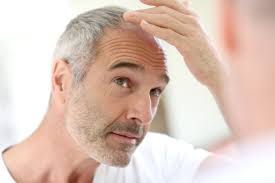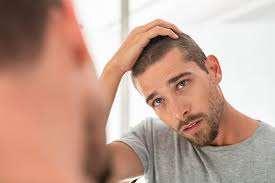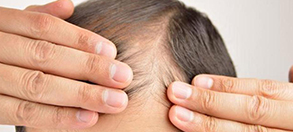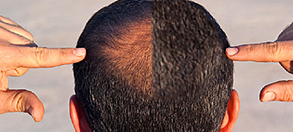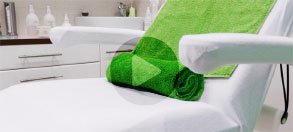Premature balding is a common cause for concern and has many potential causes, which can lead to unnatural hair loss or exacerbate a genetic predisposition to thinning hair. Regardless of gender and genetics, many people are finding that they are losing their hair more rapidly and at a younger age. Understanding the cause of your hair loss is important. Addressing your unique circumstances can help regrow hair or slow down natural hair loss. Dr. Goran Jezic and his team at Houston Hair Transplant Center (HHTC) have helped hundreds of people with natural and unnatural hair loss. From simple hair transplants to comprehensive non-surgical hair restoration, Dr. Jezic and his team can pause premature balding and even help regrow natural hair. Your hair restoration begins at our Houston offices.
To find out more, schedule a complimentary consultation at our Houston office. Here, we will assess your unique circumstances and premature balding and hair thinning causes. If you’d like to speak with our offices directly, call us at (713) 864-2300.
What is Premature Balding?
Hair loss is a natural – and common – sign of aging. It is so prevalent, in fact, that half of women and 80% of men will experience thinning hair during their lifetime.[1] Although it is common, hair loss is seen as an unwanted symptom of aging. But, balding doesn’t exclusively affect the older crowd. A quarter of the men who lose their hair first see thinning hair around 21 years old.[2] Their hair loss can occur rapidly, leading to
A receding hairline
Thinner hair
Slower hair regrowth
Patchiness on the top of the head
Causes of Premature Balding
Natural, genetic hair loss is called androgenetic alopecia (AA). As the most common form of alopecia, AA can affect anyone past puberty. However, there are many other causes of hair loss, which can exacerbate hair loss in those who have AA. If you have noticed a receding hairline or thinner hair, there might be an extrinsic cause. These causes of hair loss include but are not limited to:
Stress
In times of high stress, many people see their hair thinning or falling out completely. Obviously, hair that falls out in patches can be cause for concern. Researchers have discovered that our body’s reaction to stress, the release of cytokines and pro-inflammatory effects, damage hair follicles.[3] This damage leads the follicular structures to grow back brittle hair or no hair at all. But, this type of hair loss is not permanent. Healthy, natural hair can regrow once stress levels even out for those who don’t have AA.
Nutrient Deficiency
In recent years, we have found significant connections between necessary nutrients and minerals and their effects on hair growth. Nutrients like zinc, iron and various B vitamins contribute to the physiological process of hair growth. Without a sufficient supply of them in our diet, our body doesn’t have the necessary resources to keep premature balding at bay. Most notably, vitamin D deficiency has been closely linked to the premature onset of AA.[4] Likewise, their study also shows that when vitamin D levels improve, hair loss also improves. To read more about nutrients and supplements for hair loss, visit our blog post on the subject!
Hormone Imbalance
Various sex-specific hormones like androgens are key factors for growing thick, pigmented strands of hair,[5] also called terminal hair. Because these hormones increase during puberty, we see terminal hair grow in various spots on our bodies. When these hormones level out, hair growth typically stabilizes. However, when hormone levels fluctuate after puberty, hair loss is a likely side effect. Oftentimes, hormone imbalances during pregnancy and menopause cause women to lose hair while men in andropause or those who use anabolic steroids see premature balding.
Solutions To Premature Balding
There are a couple of remedies that may alleviate signs of balding and lead to a restored, youthful appearance. These remedies include but are not limited to:
Improving Your Diet
Having a well-balanced diet is essential to getting all the necessary nutrients. When your diet improves and includes more leafy greens and other nutrient-rich foods, your body receives the proper resources to restore hair growth. Ask Dr. Jezic about vitamins and supplements to help with hair growth during your free consultation.
Managing Stress
As mentioned before, stress can be a catalyst for hair loss. When we focus on managing our stress, our body reverses its inflammatory response and the follicular cells can regrow terminal hair. When patients have come out of a stressful period in their lives, they notice natural hair regrowth. If you are currently experiencing stress-induced hair loss, please schedule a complimentary consultation with Dr. Jezic to learn more about your treatment options.
Consider An Expert’s Approach
Those with AA may feel that by slowing premature balding they are just putting off the inevitable. These solutions may help in the short term, but most patients want long-term results. Dr. Jezic is a leader in the hair transplantation industry and has had a decade of helping patients regrow their natural hair. Unlike the other solutions to premature balding, Dr. Jezic’s expert approach allows for long-lasting results.
Personal Consultation
At your initial consultation, Dr. Jezic will perform a brief new patient intake interview and a hair loss assessment along with a review of your medical history, medications and any health conditions – past or present. Dr. Jezic will ask questions to see if your premature balding is caused by intrinsic or extrinsic factors before recommending a treatment plan. He uses two different hair transplant technologies. Both of these employ the follicular unit extraction (FUE) technique. In an FUE session, we extract healthy hair grafts from the back or sides of the head. Dr. Jezic prepares these follicles and reintroduces them into the balding or thinning areas. These follicles then make a new home in these areas before growing healthy, thick hair.
ATERA Hair Transplant
The ATERA is an automated system that uses a handheld device and computer-controlled display to precisely harvest the hair grafts. The system also has a graft counter that digitally counts the number of grafts extracted. This automated experience allows for quicker procedures and uniform results. The device carefully extracts the desired number of grafts and stores them in an optimal environment until transplantation. The device transplants the follicles at even depth and equal distances, resulting in natural, even hair regrowth.
NeoGraft
NeoGraft is an FUE Technology that extracts grafts and inserts them in balding or thinning areas. With the NeoGraft device, one of our experienced hair transplant specialists removes healthy follicles from donor areas. Next, they clean and prepare them for re-entry into balding areas. Over the next couple of months, these grafts will gradually regrow natural, healthy-looking hair.
Recovery
After your hair transplant session, you will need to focus on rest and recovery. We use a local anesthetic to dull and numb pain around the scalp. When you leave our care, you will have lingering numbness and tingling around your scalp. We ask patients not to wear a hat or anything that covers their heads for the next couple of days. These can disrupt the grafts. We also ask patients to avoid strenuous activities like heavy lifting for the next couple of days.
How Much Does Hair Restoration Cost in Houston?
The cost of your hair restoration session at Houston Hair Transplant Center (HHTC) will be determined by the extent of your procedure. We will discuss and determine the cost of your care during your consultation. If you’d like to learn more about NeoGraft hair transplant pricing, go to our NeoGraft page. If you enjoyed reading this, many of our others will answer different questions about hair loss and hair restoration. If you have any questions about these procedures or more, call us at (713) 864-2300.
FAQ
Does wearing a hat cause premature balding?
Contrary to popular belief, wearing a hat often does not lead to premature balding. People have long speculated that the pressure of the hat or the lack of sunlight exposure may damage hair follicles. While these things can damage the strands of hair, they can’t damage the follicular structures. Damage to the follicular structures only comes from genetics or extrinsic factors like stress, diet, and hormones. However, it is advisable not to wear a tight cap or hat immediately following the hair transplant at least for a few days.
References
- Piraccini BM;Alessandrini A. (2014). Androgenetic alopecia. Giornale Italiano Di Dermatologia E Venereologia : Organo Ufficiale, Societa Italiana Di Dermatologia E Sifilografia, 149(1). https://pubmed.ncbi.nlm.nih.gov/24566563/
- American Hair Loss Association – Men’s Hair Loss / Introduction. (2021). Americanhairloss.org. https://www.americanhairloss.org/men_hair_loss/introduction.html
- Peters, E., Müller, Y., Snaga, W., Fliege, H., Reißhauer, A., Schmidt-Rose, T., Max, H., Schweiger, D., Rose, M., & Kruse, J. (2017). Hair and stress: A pilot study of hair and cytokine balance alteration in healthy young women under major exam stress. PloS one, 12(4), e0175904. https://doi.org/10.1371/journal.pone.0175904
- Sanke, Sarita, et al. “Study of Serum Vitamin D Levels in Men with Premature Androgenetic Alopecia.” International Journal of Dermatology, vol. 59, no. 9, 9 June 2020, pp. 1113–1116, onlinelibrary.wiley.com/doi/abs/10.1111/ijd.14982, 10.1111/ijd.14982.
- Grymowicz, M., Rudnicka, E., Podfigurna, A., Napierala, P., Smolarczyk, R., Smolarczyk, K., & Meczekalski, B. (2020). Hormonal Effects on Hair Follicles. International journal of molecular sciences, 21(15), 5342. https://doi.org/10.3390/ijms21155342
